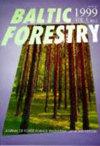Empirical observations of the yield of logs from trees of the boreal region
IF 0.6
4区 农林科学
Q3 FORESTRY
引用次数: 3
Abstract
The yield of sawlogs and plywood logs from boreal trees is discussed. First, taper curves are used to compute geometric (maximal) sawlog and plywood log contents. Then, a quality reduction is implemented, according to previously published models. Finally, the outcome is verified using empirical observations. Regarding spruce trees, the different estimates of sawlog content agree. In the case of birch and pine trees, the estimates differ. The sawlog and plywood log yield from large trees is greater than prognosticated one, probably due to missing over-aged trees in the empirical data. The yield of sawlogs and plywood logs from small trees is smaller than prognosticated one, most of the empirical data originating from thinnings with a focus on the quality of the remaining trees. The sawlog content of individual trees from clearcutting displays a skew distribution around the expected value. The distribution in thinning trunks shows a binary component, with a large proportion of trees with zero sawlog content. Keywords: sawlog; plywoodlog; Picea abies; Betula species; Pinus sylvestris北方地区树木原木产量的经验观察
讨论了北方乔木锯材和胶合板原木的产量。首先,锥度曲线用于计算几何(最大)锯木和胶合板原木含量。然后,根据先前发布的模型,实现质量降低。最后,用实证观察对结果进行验证。关于云杉树,不同的锯木含量估计是一致的。在桦树和松树的情况下,估计不同。大型树木的锯木和胶合板原木产量大于预测产量,可能是由于经验数据中缺少超龄树木。小树木的锯木和胶合板原木的产量比预测的要小,大多数经验数据来自于对剩余树木质量的关注。砍伐后的单株树木的锯材含量在期望值周围呈倾斜分布。在疏伐树干中的分布呈二元分布,零锯材含量的树木占很大比例。关键词:可锯木;plywoodlog;挪威云杉;桦木属物种;抗旱性
本文章由计算机程序翻译,如有差异,请以英文原文为准。
求助全文
约1分钟内获得全文
求助全文
来源期刊

Baltic Forestry
农林科学-林学
CiteScore
1.60
自引率
0.00%
发文量
23
审稿时长
>12 weeks
期刊介绍:
The journal welcomes the original articles as well as short reports, review papers on forestry and forest science throughout the Baltic Sea region and elsewhere in the area of boreal and temperate forests. The Baltic Sea region is rather unique through its intrinsic environment and distinguished geographical and social conditions. A temperate climate, transitional and continental, has influenced formation of the mixed coniferous and deciduous stands of high productivity and biological diversity. The forest science has been affected by the ideas from both the East and West.
In 1995, Forest Research Institutes and Universities from Estonia, Latvia and Lithuania
joined their efforts to publish BALTIC FORESTRY.
 求助内容:
求助内容: 应助结果提醒方式:
应助结果提醒方式:


